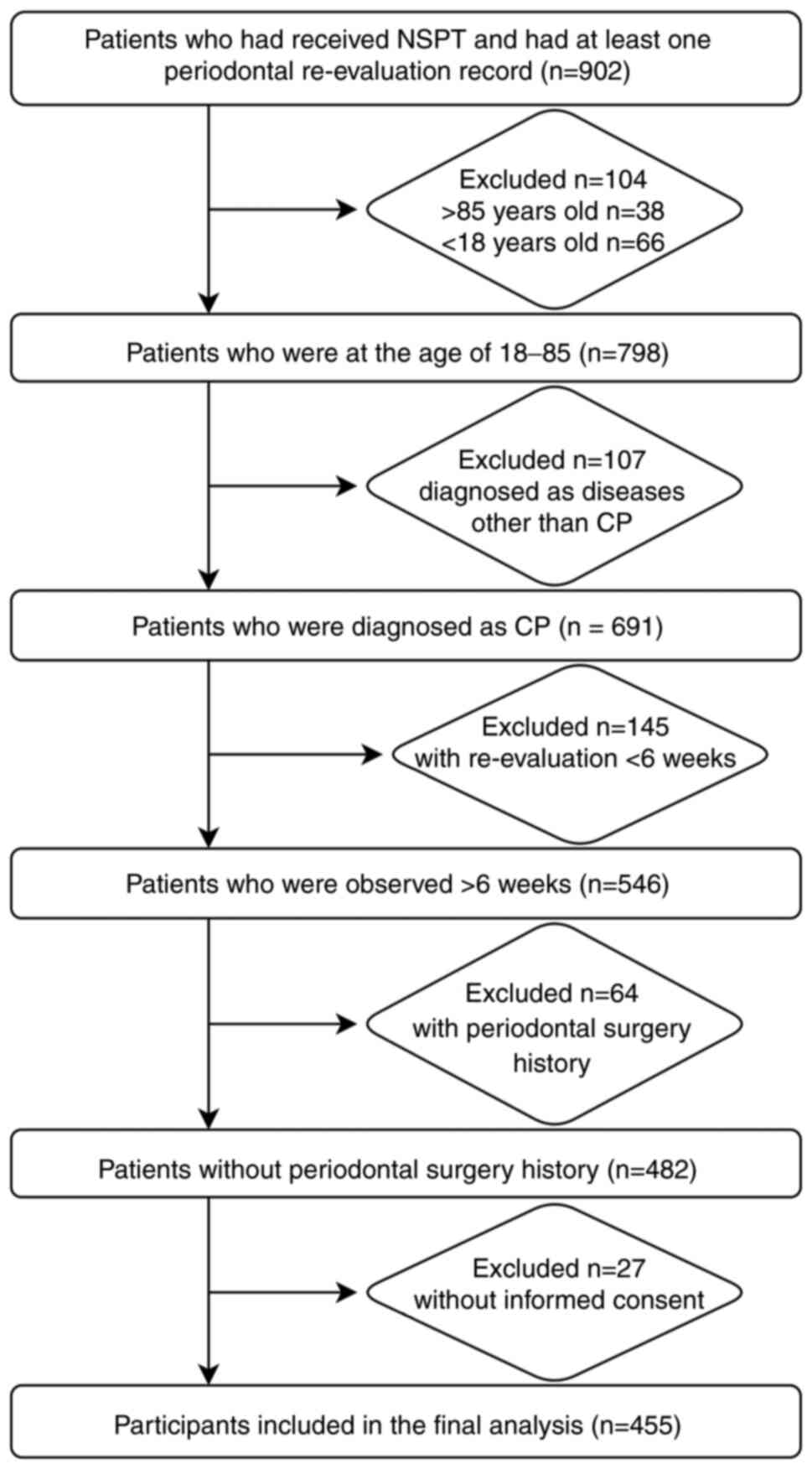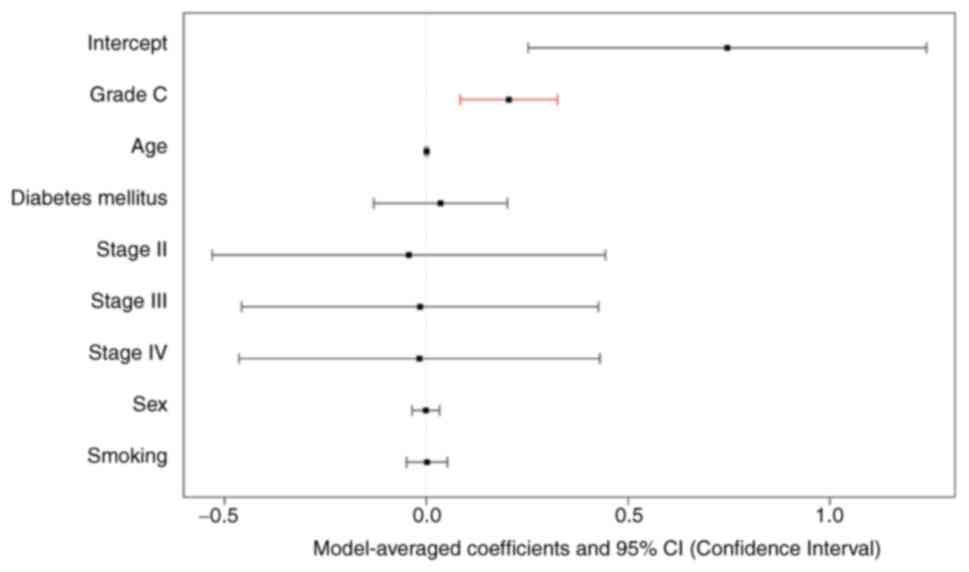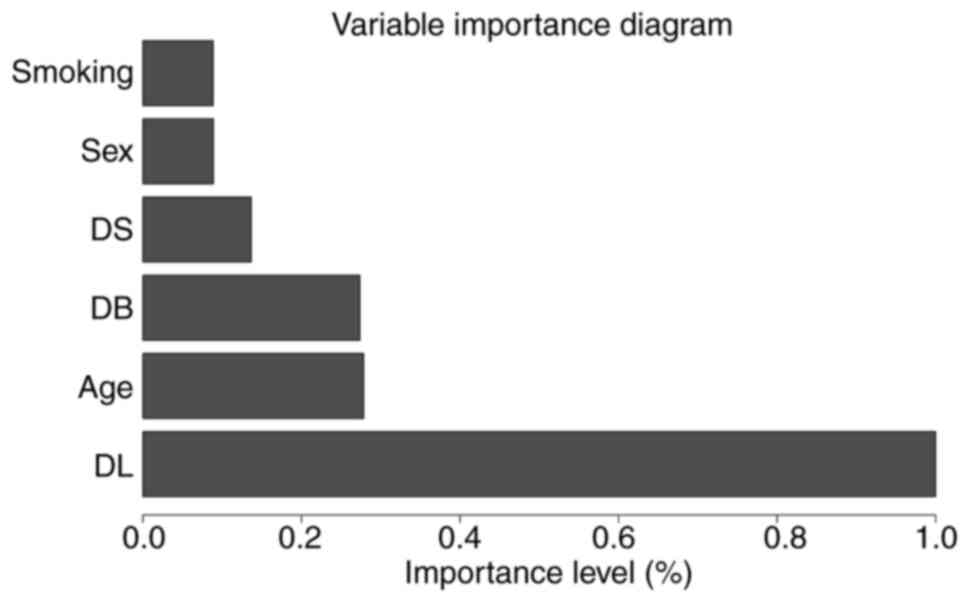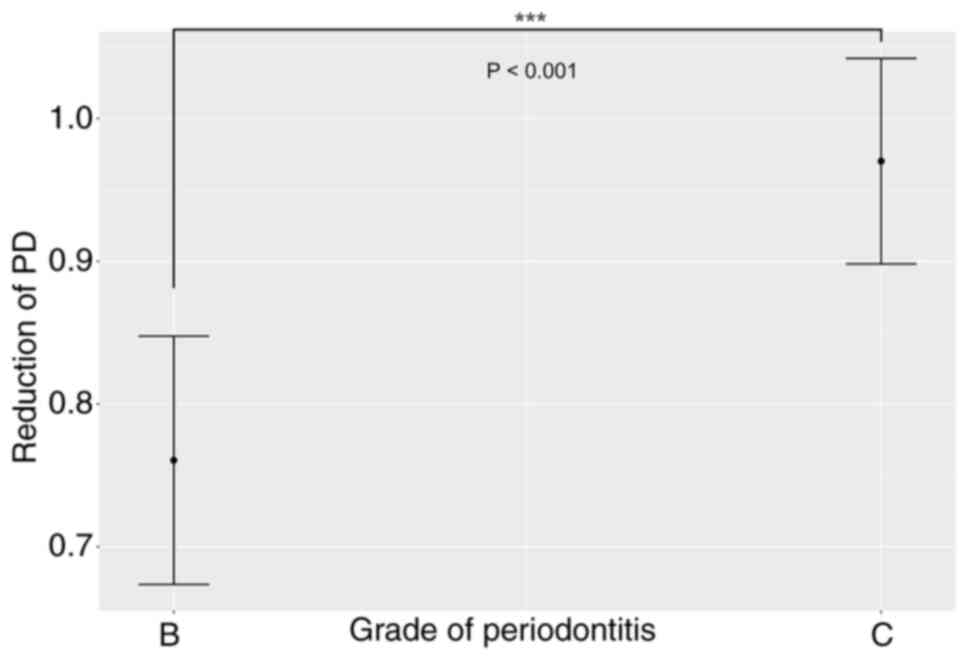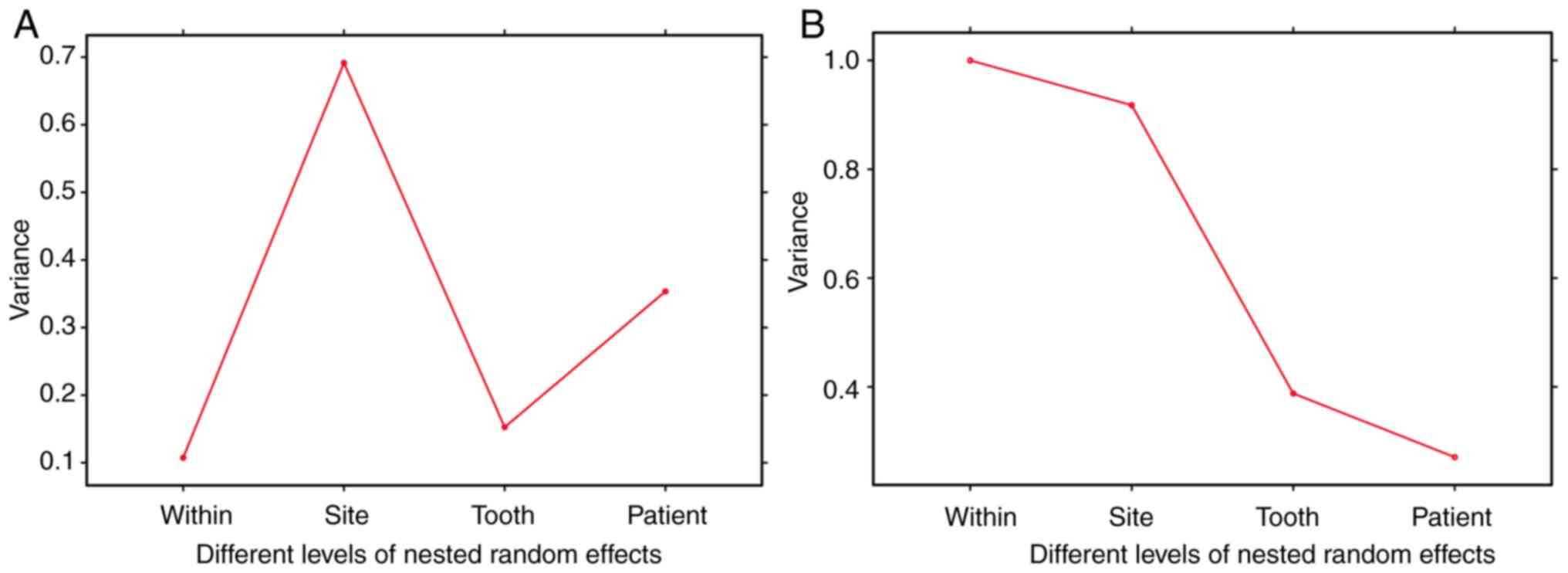|
1
|
Kapila YL: Oral health's inextricable
connection to systemic health: Special populations bring to bear
multimodal relationships and factors connecting periodontal disease
to systemic diseases and conditions. Periodontol 2000. 87:11–16.
2021.PubMed/NCBI View Article : Google Scholar
|
|
2
|
Genco RJ and Sanz M: Clinical and public
health implications of periodontal and systemic diseases: An
overview. Periodontol 2000. 83:7–13. 2020.PubMed/NCBI View Article : Google Scholar
|
|
3
|
Tonetti MS, Greenwell H and Kornman KS:
Staging and grading of periodontitis: Framework and proposal of a
new classification and case definition. J Periodontol. 89 (Suppl
1):S159–S172. 2018.PubMed/NCBI View Article : Google Scholar
|
|
4
|
Trombelli L, Franceschetti G and Farina R:
Effect of professional mechanical plaque removal performed on a
long-term, routine basis in the secondary prevention of
periodontitis: A systematic review. J Clin Periodontol. 42 (Suppl
16):S221–S236. 2015.PubMed/NCBI View Article : Google Scholar
|
|
5
|
Liu HJ, Wang B, Wang AC, Zhang DH, Mao C
and Li QH: Prognostic factors affecting the short-term efficacy of
non-surgical treatment of chronic periodontitis: A multilevel
modeling analysis. Eur J Med Res. 26(50)2021.PubMed/NCBI View Article : Google Scholar
|
|
6
|
Corbella S, Calciolari E, Alberti A, Donos
N and Francetti L: Systematic review and meta-analysis on the
adjunctive use of host immune modulators in non-surgical
periodontal treatment in healthy and systemically compromised
patients. Sci Rep. 11(12125)2021.PubMed/NCBI View Article : Google Scholar
|
|
7
|
Goh EXJ and Ong MMA: Anatomical,
microbiological, and genetic considerations in treatment of Chinese
periodontal patients. J Investig Clin Dent.
10(e12381)2019.PubMed/NCBI View Article : Google Scholar
|
|
8
|
Hannigan A and Lynch CD: Statistical
methodology in oral and dental research: Pitfalls and
recommendations. J Dent. 41:385–392. 2013.PubMed/NCBI View Article : Google Scholar
|
|
9
|
Masood M, Masood Y and Newton J: The
clustering effects of surfaces within the tooth and teeth within
individuals. J Dent Res. 94:281–288. 2015.PubMed/NCBI View Article : Google Scholar
|
|
10
|
Jiao J, Zhang L, Meng HX, Shi D, Lu RF, Xu
L, Feng XH and Cao ZQ: Clinical performance of non-surgical
periodontal therapy in a large Chinese population with generalized
aggressive periodontitis. J Clin Periodontol. 45:1184–1197.
2018.PubMed/NCBI View Article : Google Scholar
|
|
11
|
Jiao J, Shi D, Cao ZQ, Meng HX, Lu RF,
Zhang L, Song Y and Zhao JR: Effectiveness of non-surgical
periodontal therapy in a large Chinese population with chronic
periodontitis. J Clin Periodontol. 44:42–50. 2017.PubMed/NCBI View Article : Google Scholar
|
|
12
|
Pandis N, Walsh T, Polychronopoulou A and
Eliades T: Cluster randomized clinical trials in orthodontics:
Design, analysis and reporting issues. Eur J Orthod. 35:669–675.
2013.PubMed/NCBI View Article : Google Scholar
|
|
13
|
Papapanou PN, Sanz M, Buduneli N, Dietrich
T, Feres M, Fine DH, Flemmig TF, Garcia R, Giannobile WV, Graziani
F, et al: Periodontitis: Consensus report of workgroup 2 of the
2017 World Workshop on the classification of periodontal and
peri-implant diseases and conditions. J Periodontol. 89 (Suppl
1):S173–S182. 2018.PubMed/NCBI View Article : Google Scholar
|
|
14
|
Harrison XA, Donaldson L, Correa-Cano ME,
Evans J, Fisher DN, Goodwin CE, Robinson BS, Hodgson DJ and Inger
R: A brief introduction to mixed effects modelling and multi-model
inference in ecology. PeerJ. 6(e4794)2018.PubMed/NCBI View Article : Google Scholar
|
|
15
|
Bates D, Mächler M, Bolker B and Walker S:
Fitting linear mixed-effects models using lme4 arXiv: Jun 23, 2014
(Epub ahead of print).
|
|
16
|
Team RC: R: A language and environment for
statistical computing. R Foundation for Statistical Computing,
Vienna. Available from: http://www.R-project.org/2013.
|
|
17
|
Barton K: MuMIn: Multi-Model Inference.
Available from: http://r-forge.r-project.org/projects/mumin/2009.
|
|
18
|
Posada D and Buckley TR: Model selection
and model averaging in phylogenetics: Advantages of akaike
information criterion and bayesian approaches over likelihood ratio
tests. Syst Biol. 53:793–808. 2004.PubMed/NCBI View Article : Google Scholar
|
|
19
|
Awodutire PO, Ilori OR, Uwandu C and
Akadiri OA: Pilot study of new statistical models for prognostic
factors in short term survival of oral cancer. Afr Health Sci.
22:310–317. 2022.PubMed/NCBI View Article : Google Scholar
|
|
20
|
Nakagawa S, Schielzeth H and O'Hara RB: A
general and simple method for obtaining R2 from generalized linear
mixed-effects models. Methods in Ecology and Evolution. Available
from: https://doi.org/10.1111/j.2041-210x.2012.00261.x,
2012.
|
|
21
|
Wan CP, Leung WK, Wong MC, Wong RM, Wan P,
Lo EC and Corbet EF: Effects of smoking on healing response to
non-surgical periodontal therapy: A multilevel modelling analysis.
J Clin Periodontol. 36:229–239. 2009.PubMed/NCBI View Article : Google Scholar
|
|
22
|
Van Der Weijden GA and Timmerman MF: A
systematic review on the clinical efficacy of subgingival
debridement in the treatment of chronic periodontitis. J Clin
Periodontol. 29 (Suppl 3):55–71. 2002.PubMed/NCBI View Article : Google Scholar
|
|
23
|
Feng X, Zhu L, Xu L, Meng H, Zhang L, Ren
X, Lu R, Tian Y, Shi D and Wang X: Distribution of 8 periodontal
microorganisms in family members of Chinese patients with
aggressive periodontitis. Arch Oral Biol. 60:400–407.
2015.PubMed/NCBI View Article : Google Scholar
|
|
24
|
Li Y, Feng X, Xu L, Zhang L, Lu R, Shi D,
Wang X, Chen F, Li J and Meng H: Oral microbiome in chinese
patients with aggressive periodontitis and their family members. J
Clin Periodontol. 42:1015–1023. 2015.PubMed/NCBI View Article : Google Scholar
|
|
25
|
Zhou M, Rong R, Munro D, Zhu C, Gao X,
Zhang Q and Dong Q: Investigation of the effect of type 2 diabetes
mellitus on subgingival plaque microbiota by high-throughput 16S
rDNA pyrosequencing. PLoS One. 8(e61516)2013.PubMed/NCBI View Article : Google Scholar
|
|
26
|
Nascimento GG, Dahlén G, López R and
Baelum V: Periodontitis phenotypes and clinical response patterns
to non-surgical periodontal therapy: Reflections on the new
periodontitis classification. Eur J Oral Sci. 128:55–65.
2020.PubMed/NCBI View Article : Google Scholar
|
|
27
|
Chen MH, Yin HJ, Chang HH, Kao CT, Tu CC
and Chen YW: Baseline probing depth and interproximal sites predict
treatment outcomes of non-surgical periodontal therapy. J Dent Sci.
15:50–58. 2020.PubMed/NCBI View Article : Google Scholar
|
|
28
|
Song J, Zhao H, Pan C, Li C, Liu J and Pan
Y: Risk factors of chronic periodontitis on healing response: A
multilevel modelling analysis. BMC Med Inform Decis Mak.
17(135)2017.PubMed/NCBI View Article : Google Scholar
|
|
29
|
Tomasi C, Leyland AH and Wennström JL:
Factors influencing the outcome of non-surgical periodontal
treatment: A multilevel approach. J Clin Periodontol. 34:682–690.
2007.PubMed/NCBI View Article : Google Scholar
|
|
30
|
Lu RF, Xu L, Feng XH, Wang XE and Meng HX:
Multilevel analysis of non-surgical periodontal treatment of
patients with generalised aggressive periodontitis. Chin J Dent
Res. 24:191–198. 2021.PubMed/NCBI View Article : Google Scholar
|
|
31
|
Rahim-Wöstefeld S, Kronsteiner D, El-Sayed
S, El-Sayed N, Eickholz P and Pretzl B: Development of a prognostic
tool: Based on risk factors for tooth loss after active periodontal
therapy. Clin Oral Investig. 26:813–822. 2022.PubMed/NCBI View Article : Google Scholar
|
|
32
|
Scribante A, Gallo S, Pascadopoli M, Frani
M and Butera A: Ozonized gels vs chlorhexidine in non-surgical
periodontal treatment: A randomized clinical trial. Oral Dis.
30:3993–4000. 2024.PubMed/NCBI View Article : Google Scholar
|
|
33
|
Elbay M, Elbay ÜS, Kaya E and Kalkan ÖP:
Effects of photobiomodulation with different application parameters
on injection pain in children: A randomized clinical trial. J Clin
Pediatr Dent. 47:54–62. 2023.PubMed/NCBI View Article : Google Scholar
|
|
34
|
Butera A, Pascadopoli M, Nardi MG, Ogliari
C, Chiesa A, Preda C, Perego G and Scribante A: Clinical use of
paraprobiotics for pregnant women with periodontitis: Randomized
clinical trial. Dent J (Basel). 12(116)2024.PubMed/NCBI View Article : Google Scholar
|
|
35
|
Mdala I, Haffajee AD, Socransky SS, de
Blasio BF, Thoresen M, Olsen I and Goodson JM: Multilevel analysis
of clinical parameters in chronic periodontitis after root
planing/scaling, surgery, and systemic and local antibiotics:
2-year results. J Oral Microbiol. 4:2012.PubMed/NCBI View Article : Google Scholar
|



